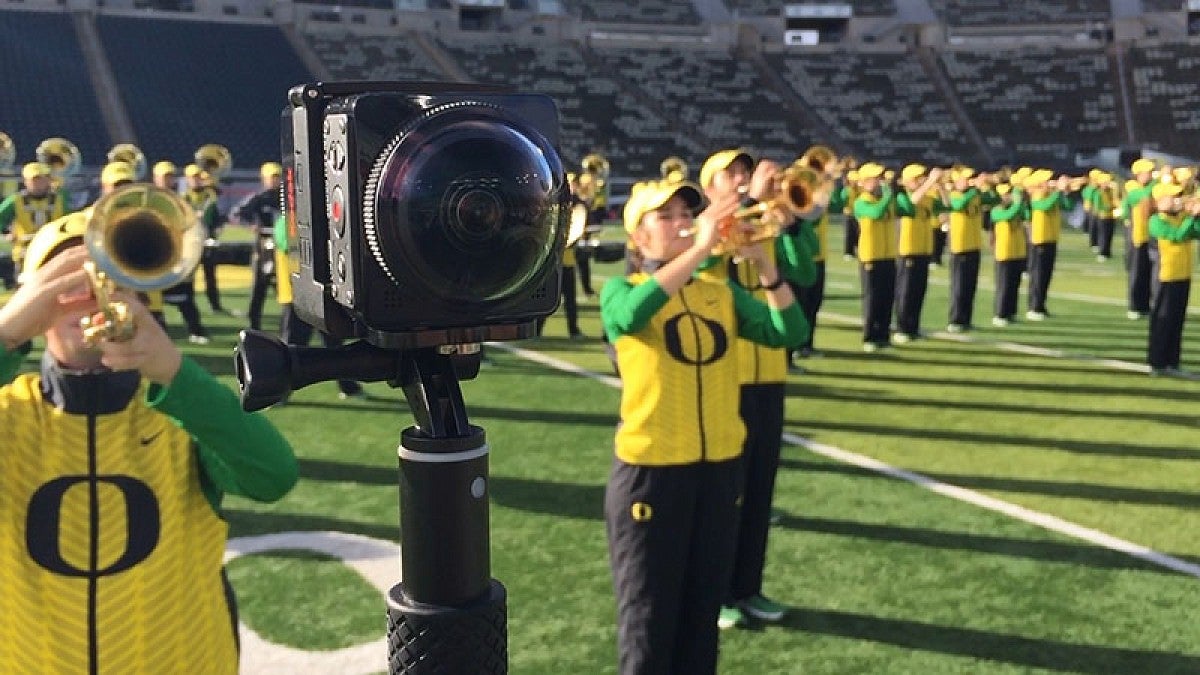For anyone who’s ever wondered what it would be like to perform with the Oregon Marching Band in front of a packed crowd at Autzen Stadium, a new series of 360-degree “virtual reality” videos are about as close as it comes to the real thing.
“Stepping into Autzen is an awe-inspiring event,” said Nick Bonnema, a psychology major from Beaverton who plays trombone in the band. “(These videos) allow them to experience the game as if they’re there, instead of seeing just what the director of the video wants them to see.”
The School of Music and Dance has produced highlights from several home games over the last football season using the immersive new medium. They include: a rousing rendition of the school’s fight song “Mighty Oregon”; a complete halftime show featuring a medley of Jimi Hendrix’ greatest hits; a powerful performance of the national anthem with a flyover from a trained bald eagle; dance routines and aerial stunts from the Oregon Cheerleaders; and scenes of the marching band providing its unique brand of musical motivation from the stands, along with a special guest appearance from The Duck.
The videos were captured using two wide-angle cameras, each simultaneously recording at four times the resolution of high-definition television. These huge video files were then stitched together with advanced editing software to create interactive videos that let viewers choose exactly where they want to look, in real time, around a seamless 360-degree scene.
“They’re seeing a whole new perspective that you don’t get unless you’re actually marching in the band,” said Gabby Socolofsky, a flute-playing freshman from Lake Oswego.
The view can be controlled simply by moving a smartphone with the latest version of the YouTube app. On a desktop computer, the perspective can be changed with the mouse or by using the “a,” “s,” “d” and “w” keys on the keyboard.
Band member Kylee Striplin, a social science and popular music major who plays flute and trombone, said she was excited to share the videos with friends and family who often have trouble picking her out of the crowd on game day.
“With this close-up view, I can tell them which yard line I’m on and they can turn the camera and see me,” Striplin said.
Anna Frazer, the band’s administrative coordinator, said one of her favorite videos showed Challenger, the free-flying bald eagle, soaring over Autzen Stadium during a pregame performance of “Stars and Stripes.”
“It was incredible,” Frazer said. “I’ve seen an eagle fly before, but choreographed with the music, it was very moving. I was just watching thinking, ‘This is amazing.’”
Director of Athletic Bands Eric Wiltshire said the 360-degree videos gave him an even better view of the marching band’s halftime show than the prime position he’s occupied on the sidelines near the 50-yard line for the past 11 seasons.
“I like the immersiveness of it,” Wiltshire said. “I could look and focus on individuals a whole lot more easily.”
Wiltshire said he hoped the videos would inspire the next generation of Oregon Marching Band members.
“If they’re high school students who want to be in the band, I hope they can see people who are like them having a great time and see a place for themselves in the group,” he said.
Wiltshire said he was already developing a new routine for the band that would be especially tailored to the 360-degree format, a concept he called “inverse theater in the round.”
Brad Foley, dean of the School of Music and Dance, said he was looking forward to using the technology to share student and faculty performances with people who can’t attend live events in person.
“We’re a school of music and dance, we want people to see and hear what we do,” Foley said. “This technology allows us to transport audiences from all over the world right onto the field at Autzen Stadium with our marching band, up on stage at Beall Hall with our jazz ensemble, or out under the spotlights at the Hult Center with our faculty and student performers in a way that was not possible before.”
—By Steve Fyffe, School of Music and Dance


